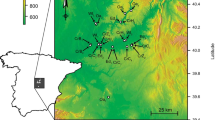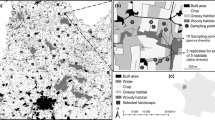Abstract
Despite good theoretical knowledge about determinants of plant species richness in mosaic landscapes, validations based on complete surveys are scarce. We conducted a case study in a highly fragmented, traditional agricultural landscape. In 199 patches of 20 representative multi-patch-plots (MPPs, 1 ha) we recorded a total of 371 plant species. In addition to an additive partitioning of species diversity at the (a) patch- and (b) MPP-scale, we adopted the recently proposed ‘specificity’ measure to quantify the contribution of a spatial subunit to landscape species richness (subunit-to-landscape-contribution, SLC). SLC-values were calculated at both scales with respect to various spatial extents. General regression models were used to quantify the relative importance of hypothesis-driven determinants for species richness and SLC-values.
At the patch scale, habitat type was the main determinant of species richness, followed by area and elongated shape. For SLC-values, area was more important than habitat type, and its relevance increased with the extent of the considered landscape. Influences of elongated shape and vegetation context were minor. Differences between habitat types were pronounced for species richness and also partly scale-dependent for SLC-values.
Relevant predictors at the MPP-scale were nonlinear habitat richness, the gradient from anthropogenic to seminatural vegetation, and the proportions of natural vegetation and rare habitats. Linear elements and habitat configuration did not contribute to species richness and SLC. Results at the MPP-scale were in complete accordance with the predictions of the mosaic concept. Hence, our study represents its first empirical validation for plant species diversity in mosaic landscapes.
Similar content being viewed by others
References
Alard D, Poudevigne I (2000) Diversity patterns in grasslands along a landscape gradient in northwestern France. J Vegetat Sci 11:287–294
Allan JD (1975) Components of diversity. Oecologia 18:359–367
Arrhenius O (1921) Species and area. J Ecol 9:95–99
Baudry J, Burel F, Thenail C, Le Coeur D (2000) A holistic landscape ecological study of the interactions between farming activities and ecological patterns in Brittany, France. Landscape Urban Plan 50:119–128
Bossuyt B, Hermy M (2004) Species turnover at small scales in dune stack plant communities. Basic Appl Ecol 5:321–329
Brose U (2001) Relative importance of isolation, area and habitat heterogeneity for vascular plant species richness of temporary wetlands in east-German farmland. Ecography 24:722–730
Bruun HH (2000) Patterns of species richness in dry grassland patches in an agricultural landscape. Ecography 23:641–650
Bruun HH (2001) Determinants of species richness in patches of grassland and heathland in Himmerland (Denmark). Nordic J Bot 21:607–614
Burel F, Baudry J, Butet A, Clergeau P, Delettre Y, Le Coeur D, Dubs F, Morvan N, Paillat G, Petit S, Thenail C, Brunel E, Lefeuvre JC (1998) Comparative biodiversity along a gradient of agricultural landscapes. Acta Oecol-Int J Ecol 19:47–60
Connor EF, McCoy ED (1979) The statistics and biology of the species–area relationship. Am Natural 113:791–833
Crist TO, Veech JA, Gering JC, Summerville KS (2003) Partitioning species diversity across landscapes and regions: a hierarchical analysis of alpha, beta, and gamma diversity. Am Natural 162:734–743
Dauber J, Hirsch M, Simmering D, Waldhardt R, Otte A, Wolters V (2003) Landscape structure as an indicator of biodiversity: matrix effects on species richness. Agric Ecosyst Environ 98:321–329
Davis JC (1986) Statistics and data analysis in geology. Wiley & Sons, New York, USA
Duelli P (1992) Mosaikkonzept und Inseltheorie in der Kulturlandschaft. Verhandlungen Gesellschaft Ökol 21:379–384
Duelli P (1997) Biodiversity evaluation in agricultural landscapes: an approach at two different scales. Agric Ecosyst Environ 62:81–91
Ellenberg H (1996) Die Vegetation Mitteleuropas mit den Alpen in ökologischer, dynamischer und historischer Sicht. Ulmer, Stuttgart, Germany
Eriksson A, Eriksson O, Berglund H (1995) Species abundance patterns of plants in Swedish seminatural pastures. Ecography 18:310–317
Fahrig L (2005) When is a landscape perspective important. In: Wiens JA, Moss M (eds) Issues and perspectives in landscape ecology. Cambridge University Press, Cambridge, UK, pp 3–10
Firbank LG (2005) Striking a new balance between agricultural production and biodiversity. Ann Appl Biol 146:163–175
Fleishman E, Betrus CJ, Blair RB (2003) Effects of spatial scale and taxonomic group on partitioning of butterfly and bird diversity in the Great Basin. USA Landscape Ecol 18:675–685
Forman RTT (1995) Land mosaics. Cambridge University Press, Cambridge, UK
Forman RTT (2002) Foreword. In: Gutzwiller K (ed) Applying landscape ecology in biological conservation. Springer, New York, NY, USA, pp vii–x
Gering JC, Crist TO (2002) The alpha–beta-regional relationship: providing new insights into local-regional patterns of species richness and scale dependence of diversity components. Ecol Lett 5:433–444
Gering JC, Crist TO, Veech JA (2003) Additive partitioning of species diversity across multiple spatial scales: implications for regional conservation of biodiversity. Conserv Biol 17:488–499
Gerowitt B, Bertke E, Hespelt SK, Tute C (2003) Towards multifunctional agriculture—weeds as ecological goods? Weed Res 43:227–235
Griffith DA (1982) Geometry and spatial interaction. Ann Assoc Am Geograph 72:332–346
Gutzwiller KJ (ed) (2002) Applying landscape ecology in biological conservation. Springer, New York, USA
Hanski I, Gyllenberg M (1997) Uniting two general patterns in the distribution of species. Science 275:397–400
Hansson L, Angelstam P (1991) Landscape ecology as a theoretical basis for nature conservation. Landscape Ecol 5:191–201
Hietala-Koivu R, Jarvenpaa T, Helenius J (2004) Value of semi-natural areas as biodiversity indicators in agricultural landscapes. Agric Ecosyst Environ 101:9–19
Hietel E, Waldhardt R, Otte A (2004) Analysing land-cover changes in relation to environmental variables in Hesse, Germany. Landscape Ecol 19:473–489
Hietel E, Waldhardt R, Otte A (2005) Linking socio-economic factors, environment and land cover in the German Highlands, 1945–1999. J Environ Manage 75:133–143
Hoffmann-Kroll R, Schafer D, Seibel S (2003) Landscape indicators from ecological area sampling in Germany. Agric Ecosyst Environ 98:363–370
Huston MA (1994) Biological diversity—the coexistence of species on changing landscapes. Cambridge University Press, Cambridge
Jeanneret P, Schupbach B, Luka H (2003) Quantifying the impact of landscape and habitat features on biodiversity in cultivated landscapes. Agric Ecosyst Environ 98:311–320
Keeley JE, Fotheringham CJ (2005) Plot shape effects on plant species diversity measurements. J Veget Sci 16:249–256
Kent M, Coker P (1992) Vegetation description and analysis—a practical approach. Wiley & Sons, Chichester, England
Kunin WE (1997) Sample shape, spatial scale and species counts: implications for reserve design. Biol Conserv 82:369–377
Lande R (1996) Statistics and partitioning of species diversity, and similarity among multiple communities. Oikos 76:5–13
Le Coeur D, Baudry J, Burel F, Thenail C (2002) Why and how we should study field boundary biodiversity in an agrarian landscape context. Agric Ecosyst Environ 89:23–40
Legendre P, Legendre L (1998) Numerical ecology. Elsevier Science BV, Amsterdam, the Netherlands
Lewontin RC (1972) The apportionment of human diversity. Evolution Biol 6:381–398
Liu J, Taylor WW (2002) Integrating landscape ecology into natural resource management. Cambridge University Press, Cambridge, UK
Loreau M (2000) Are communities saturated? On the relationship between alpha, beta and gamma diversity. Ecol Lett 3:73–76
Ma MH, Tarmi S, Helenius J (2002) Revisiting the species–area relationship in a semi-natural habitat: floral richness in agricultural buffer zones in Finnland. Agric Ecosyst Environ 89:137–148
Magurran AE (2004) Measuring biological diversity. Blackwell, Oxford, UK
Mantel N (1967) The detection of disease clustering and generalized regression approach. Cancer Res 27:209–220
Marshall EJR, Moonen AC (2002) Field margins in northern Europe: their functions and interactions with agriculture. Agric Ecosyst Environ 89:5–21
McCune B, Mefford MJ (1999) PC-ORD—multivariate analysis of ecological data. MjM Software, Gleneden Beach Oregon USA
McGarigal K, Marks BJ (1995) FRAGSTATS: spatial pattern analysis program for quantifying landscape structure. Gen. Tech. Rep. PNW-GTR-351 US Dep. Agric. For. Serv. Pacific Northwest Research Station, Portland, OR, USA, pp 1–122
Neßhöver C (1999) Charakterisierung der Vegetationsdiversität eines Landschaftsausschnittes durch funktionelle Attribute von Pflanzen – Ein Beispiel aus der Nördlichen Frankenalb. Bayreuther Forum ökol 69:1–114
Ortega M, Elena-Rosello R, Del Barrio JMG (2004) Estimation of plant diversity at landscape level: a methodological approach applied to three Spanish rural areas. Environ Monitor Assess 95:97–116
Peterseil J, Wrbka T, Plutzar C, Schmitzberger I, Kiss A, Szerencsits E, Reiter K, Schneider W, Suppan F, Beissmann H (2004) Evaluating the ecological sustainability of Austrian agricultural landscapes—the SINUS approach. Land Use Policy 21:307–320
Potts MD, Plotkin JB, Lee HS, Manokaran N, Ashton PS, Bossert WH (2001) Sampling biodiversity: effects of plot shape. Malaysian Forest: 29–34
Preston WF (1960) Time and space and the variation of species. Ecology 41:611–627
Retzer V (1999) Charakterisierung und Vergleich der Vegetationsdiversität zweier Kulturlandschaften—Untersuchungen anhand systematischer Rastermethoden in Frankenalb und Fichtelgebirge—Eine Methodenkritik. Bayreuther Forum Ökologie 69:117–206
Ricotta C (2003) Additive partition of parametric information and its associated beta-diversity measure. Acta Biotheoret 51:91–100
Riitters KH, O’Neill RV, Hunsaker CT, Wickham JD, Yankee DH, Timmins SP, Jones KB, Jackson BL (1995) A factor-analysis of landscape pattern and structure metrics. Landscape Ecol 10:23–39
Roschewitz I, Gabriel D, Tscharntke T, Thies C (2005) The effects of landscape complexity on arable weed species diversity in organic and conventional farming. J Appl Ecol 42:873–882
Rosenzweig ML (1995) Species diversity in space and time. Cambridge University Press, Cambridge, UK
Scheiner SM (2003) Six types of species–area curves. Global Ecol Biogeogr 12:441–447
Scheiner SM (2004) A melange of curves—further dialogue about species–area relationships. Global Ecol Biogeogr 13:479–484
Simmering D, Waldhardt R, Otte A (2001) Syndynamics and ecology of Scotch Broom stands in the Lahn-Dill-Highlands (Germany). Tuexenia 21:51–89
StatSoft Inc. (2001) STATISTICA for Windows. www.statsoft.com.—Statsoft Inc
Steiner NC, Köhler W (2003) Effects of landscape patterns on species richness—a modelling approach. Agric Ecosyst Environ 98:353–361
Stevens J (2002) Applied multivariate statistics for the social sciences. Erlbaum Assoc, Mahwah, NJ, USA
Stoate C, Boatman ND, Borralho RJ, Carvalho CR, de Snoo GR, Eden P (2001) Ecological impacts of arable intensification in Europe. J Environ Manage 63:337–365
Stohlgren TJ, Falkner MB, Schell LD (1995) A modified-Whittaker nested vegetation sampling method. Vegetatio 117:113–121
Stohlgren TJ, Chong GW, Kalkhan MA, Schell LD (1997) Rapid assessment of plant diversity patterns: a methodology for landscapes. Environ Monitor Assess 48:25–43
Tilzey M (2000) Natural areas, the whole countryside approach and sustainable agriculture. Land Use Policy 17:279–294
Tjørve E (2002) Habitat size and number in multi-habitat landscapes: a model approach based on species–area curves. Ecography 25:17–24
Triantis KA, Mylonas M, Lika K, Vardinoyannis K (2003) A model for the species–area–habitat relationship. J Biogeogr 30:19–27
Veech JA, Summerville KS, Crist TO and Gering JC (2002) The additive partitioning of species diversity: recent revival of an old idea. Oikos 99:3–9
Wagner H, Wildi O, Ewald K (2000) Additive partitioning of plant species diversity in an agricultural mosaic landscape. Landscape Ecol 15:219–227
Wagner HH, Edwards PJ (2001) Quantifying habitat specificity to assess the contribution of a patch to species richness at a landscape scale. Landscape Ecol 16:121–131
Waldhardt R, Simmering D, Otte A (2004) Estimation and prediction of plant species richness in a mosaic landscape. Landscape Ecol 19:211–226
Weber D, Hintermann U, Zangger A (2004) Scale and trends in species richness: considerations for monitoring biological diversity for political purposes. Global Ecol Biogeogr 13:97–104
Whittaker RH (1972) Evolution and measurement of species diversity. Taxon 21:213–251
Wiens JA (2005) Towards a unified landscape ecology. In: Wiens JA, Moss M (eds) Issues and perspectives in landscape ecology. Cambridge University Press, Cambridge, UK, pp 365–373
Author information
Authors and Affiliations
Corresponding author
Rights and permissions
About this article
Cite this article
Simmering, D., Waldhardt, R. & Otte, A. Quantifying determinants contributing to plant species richness in mosaic landscapes: a single- and multi-patch perspective. Landscape Ecol 21, 1233–1251 (2006). https://doi.org/10.1007/s10980-006-0027-6
Received:
Accepted:
Issue Date:
DOI: https://doi.org/10.1007/s10980-006-0027-6




